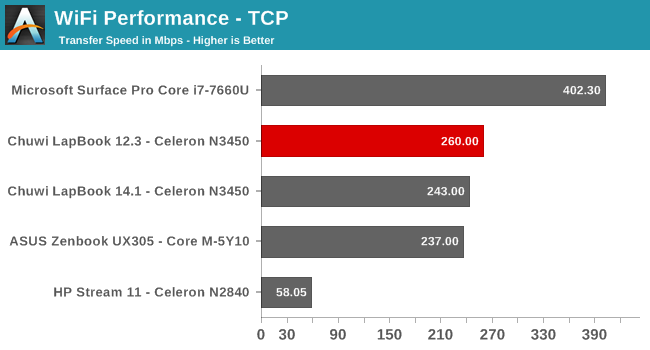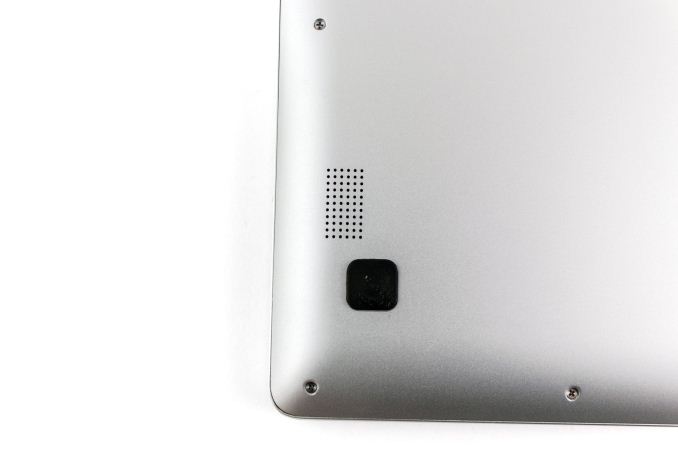The Chuwi LapBook 12.3 Review: Premium Feel, Budget Price
by Brett Howse on September 6, 2017 8:00 AM EST- Posted in
- Laptops
- Apollo Lake
- Goldmont
- Chuwi
Wireless
Chuwi has stuck with the Intel Wireless-AC 3165 NIC for the smaller LapBook, which is an 802.11ac model with a 1x1 antennae. Most Ultrabooks are going to ship with a 2x2 solution, which would double the bandwidth, but for a budget system, sticking with a cheaper 1x1 model is fine. The great part about the 3165 is that it’s 802.11ac, meaning it’s both 2.4 and 5 GHz capable, and if you have an 802.11ac access point, the performance should be reasonable.

Despite the metal chassis, the LapBook 12.3 actually outperformed the plastic LapBook 14.1, although only slightly. This is a solid wireless offering, and the Intel drivers have been, in our experience, the most stable and reliable of any of the wireless NIC cards, so it’s great to see Chuwi keep a good offering here. The 1x1 is a drawback for outright performance, but for light tasks, it’s going to be fine. You probably won’t be copying multiple GB of data to this machine over the network anyway, since the storage is so limited, but if you do, it’ll take a while.
Audio
It’s a rare laptop that manages to find a way to pack good speakers in, thanks to the cramped quarters, and the additional weight that would be required for a proper speaker magnet. Pretty much the best we can hope for is that the laptop gets reasonably loud.
This is one area where the Chuwi once again shows its budget nature. The speakers only get to around 80 dB(A) measured one inch over the trackpad at maximum volume, and the sound quality leaves a lot to be desired. No laptop can produce much sound in the lower end of the frequency range, but the Chuwi is especially poor in this regard.
Software
We mentioned this in the last Chuwi review as well, but it certainly bears mentioning again. Chuwi ships the LapBook with a bone stock Windows OS. There’s no extra software installed at all, other than the drivers for the hardware.
In an age where everyone wants to bump their margins by installing paid trail-ware on their systems, it’s impressive that one of the most budget machines around doesn’t need to do this.












60 Comments
View All Comments
tipoo - Wednesday, September 6, 2017 - link
Kind of impressive that a 3-issue core can get 70% of the way to Broadwell. Broadwell is still experientially better even with half the cores, but of course much higher power. Goldmont seems like a welcome de-crapping of Braswell.tipoo - Wednesday, September 6, 2017 - link
When you say two finger scroll is the opposite way as most laptops, do you mean scrolling down = content goes down, or the "natural" method where content tracks your fingers, push up to get to the bottom of a document?
Samus - Wednesday, September 6, 2017 - link
Yes, what is sometimes referred to as "natural" scrolling, opposed to "reversed" scrolling. Think of a flight sim where down is up and up is down.Personally, I find natural annoying (the default on Mac's) and always reverse it.
reukiodo - Thursday, September 7, 2017 - link
There is nothing natural about 'natural' scrolling. Only Mac users that have been exposed (forced) to this for a long time think this is normal. Every other human being, including kids and grandparents, by default move down to scroll down.peterfares - Thursday, September 7, 2017 - link
Windows computers nowadays use "natural" scrolling direction.I think the reasoning is the touchpad is basically "mapped" to the screen. You drag on the touchpad just as you'd drag on a touch screen which many of these laptops have nowadays.
JoeMonco - Saturday, September 9, 2017 - link
Except when using a tablet or smatphone, right?pjcamp - Tuesday, November 21, 2017 - link
Because "natural scrolling" maps exactly onto how one reads a sheet of paper -- lock your eyes in a specific direction and move the paper upwards through your field of view.Oh wait . . . .
R3MF - Wednesday, September 6, 2017 - link
Re: Linux supportAtom architectures very frequently have problems with standard linux distro's, in that they have crippled EUFI bios's, either 32bit only, or in some other way borked.
Can you install Suse or ubuntu to see if a stanard Grub2 beraing distro release can be installed on this laptop?
ThortonBe - Wednesday, September 6, 2017 - link
I would be keen to hear the answer to this as well. It seems like a pretty tempting device, but I'd want Linux on it.abufrejoval - Thursday, October 26, 2017 - link
I didn't actually install Ubuntu, but booted it from a USB stick. The BIOS has all the required settings to make Linux work in general and Ubuntu 16.04.03 had no issue with any of the hardware parts. I'm very sure it would run without any issues, just as it runs fine on the Braswell and Baytrail Atoms I own.Didn't try SuSE, CentOS etc. or Remix either.
I returned the notebook before running really extensive tests because
* M.2 slot can only hold 4cm units (I only have 8cm ones in the recyling bin)
* space bar only worked half the time (thumb keeps hitting metal strip between space bar and touch pad)
* touch pad sensitivty is far too high, cannot be truned off or configured: It's a nightmare to type on the thing
I bought it for €400 on Amazon Germany, they raised the price to €500 afterwards--somebody must have had one too many...
It came with version 1511 of Windows 10 which went out of support the day I received it. The upgrade took almost a day but was definitely worth it: It only ever ran the CPUs to full 2.1/2.22 tilt after that and Geekbench scores became quite impressive.
Reading PDFs full screen with two pages side-by-side on that display is what it seems to have been made for: Simply glorious!
A "good-enough" laptop without any moving parts, fan or disk, remains on my wish list. They were close, but fouled up the end-game.